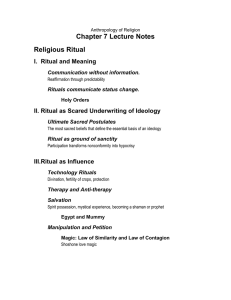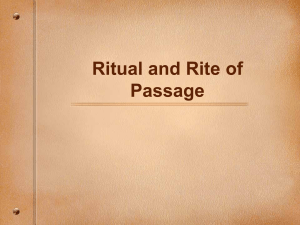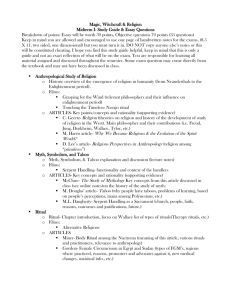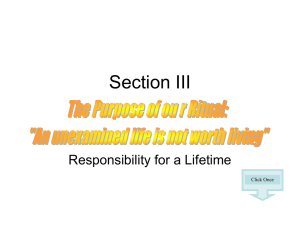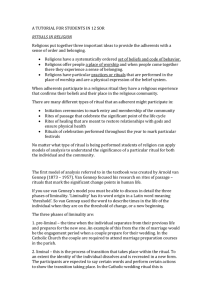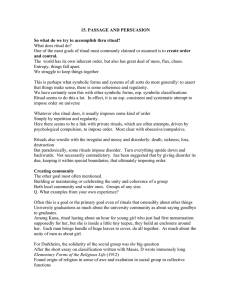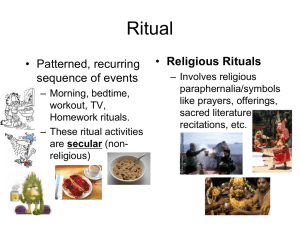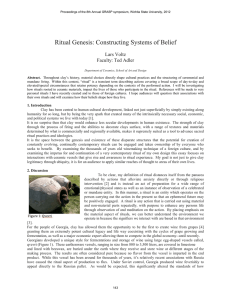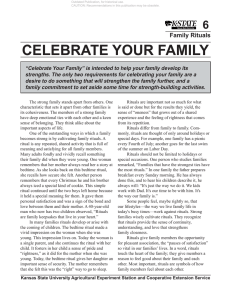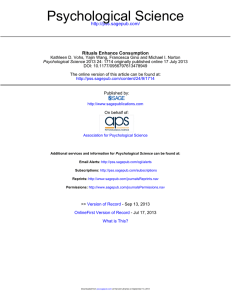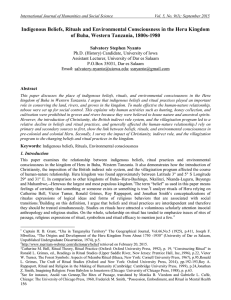Rituals in psychotherapy
advertisement
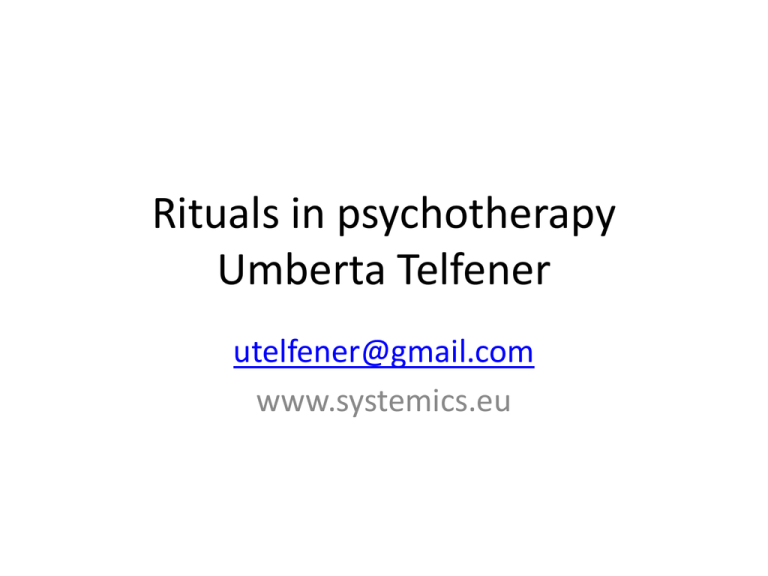
Rituals in psychotherapy Umberta Telfener utelfener@gmail.com www.systemics.eu A common ritual: creating your safe place Lets stand up, imagine the last time you felt very very well in situation in which you were alone. Where were you? Put words to how you felt. Go back to the situation, what did you see, hear and feel. Which was your posture, try and replicate it. Connect a symbol to this feeling of wellness We will try and anchor it A way of finding connections A ceremony with magical intent A way to connect to the extra dimensional world, to a higher self A shift to the right brain hemisphere and to a higher attention (going in ϐ and ϑ state) A basic means to enter an inner world, where normal limitations of time and place don’t apply. There are spontaneous and intentional rituals To follow a ritual means to use certain gestures, sounds, words, prayers, visualizations… Some intentional and repetitive ‘moves’ to work on some theme/ problems alerting the extra dimensional/ subconscious world. To create a link, to bridge the boundaries between many worlds The sacred journey of rituals The spiritual/magical dimension Insights, connections, Psychic domain: inner world The world of others: social outer world of relationships The aim is to center oneself and to reach a unitary state, a connection Rites of passage Are culturally shared steps through a door to a higher level of consciousness . A ‘trip’ as an appropriate way to enter `hidden’ knowledge, to share the `knowing’ and to be part of the group that `knows’. It is important to experience something out of the ordinary, that impresses the initiate and makes him/her aware that it has reached a `higher’ level. Awareness Awareness is the means not the purpose Becoming aware is not only a psychic event but allows the individual to inscribe into the universal. Allows the integration of the universal order, the contract between singular and universal Rituals allow to: • • • • • • • • • • • • • • Create a cybernetic brain: many hearts and minds together Access to emotions through doing Introduce oneself as a participant observer Reflect of implicit premises Make distinctions and give words to instinctive actions Accept/touch with hand complexity Enhance/learn a double positioning: be within and outside Transform structure in a process and make possible new narratives emerge Change lexicon Look for the relational configuration, identify the dance Look for the local coherence Trace resources ……………………………………….. ………………………………………….. Look for an object that can represent your pain/problem or yourself A ritual doesn't offer a structured goal/concept/ chore but acts as a mirror that reflects the awareness level of the subject. Utilizing active practices allows to make every happening a shared experience and to create new order/disorder/interaction/organization It offers an opportunity to improvise Rituals allow for new narratives to emerge: from the people involved,, from the therapeutic encounter, from the encounter in the here and now. Allow to speculate the future, to connect the past with the present. Meanings emerge from the coordination of the coordination of actions and meanings since every understanding process has a constructive and social nature We need to act reflexively Make a protective object for yourself Embodiment Physical actions, steps, postures, dances, help to ‘anchor’ resolutions and belief system’s changes (embodied cognition). Repeating gestures helps to connect body and mind Rituals can also be seen as a support to structure the chaos around, to deal with disorder (order from noise, from disorder) Especially if repeated often, they provide a structure and thus safety Repetition and rhythm With the repetition of certain mudras (gestures), visualization, special breathing, autosuggestion, mantras (specific words that have a deeper significance), symbols, patterns, in a ritual we develop a whole repertoire of tools for what we can call “the communication with the self”. Affirming and anchoring Rituals are not rational but help making connections. They function as communal memory, containing culture and cosmology. They were the vault, the carrier of shared memories, probably long before there was symbolic language. They help anchoring experiences and insights and bringing them back to reminiscence in an automatic mode There are many ways to perform a ritual: some are very specific to a special culture, others are more universal. There is no all-in-one layout. All ritual formats are intended as solemn ways to come into contact with the hidden, inside and outside yourself. A ritual allows to perform repetition, to enter an altered state of mind and to center oneself as a support for one’s own intuitive and sacred mind. How do you choose which ritual to perform? Many rituals contain the same elements. These are: purification, transformation, healing, the creation of a structure and a connection, making a link … It is important to separate from daily reality (habits), to create a division between daily routine and the place of the ritual, by actively organizing it, but also by some extra relax, fasting or by seeking out a quiet place in nature, in company of a few significant others or on one’s own. Phases • Dedication, making clear for what reason and purpose the ritual is and who is addressed to • Preparation, creating the sacred space • Purification - physical and psychological cleansing, asking for mercy and forgiveness • Celebration, what are the modalities we have decided for honoring and performing • Devotion, making oneself small, letting go of the ego • Petition, making an offering, a proposition and maybe ‘a deal’ (asking for Grace / Healing / Blessing) • Transformation: the liminality phase that seeds within Thank you for your attention!!!
